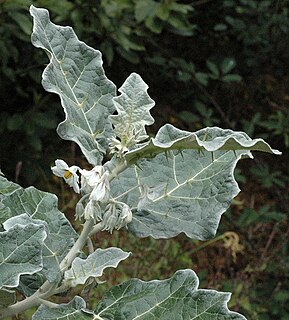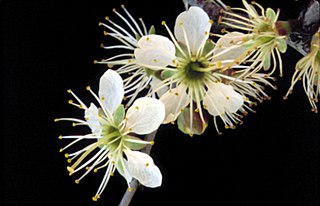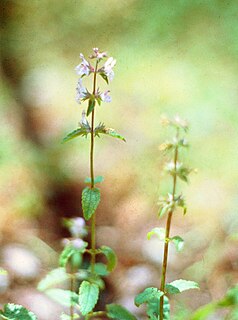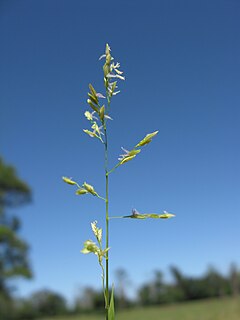
Asphodelus fistulosus is a species of plant known as hollow-stemmed asphodel, onionweed, onion-leafed asphodel, and pink asphodel. It is native to the Mediterranean region. It is an invasive exotic weed in the United States, with significant infestations in California, Arizona, New Mexico, and Texas. It is listed as a Federal Noxious Weed by the United States Department of Agriculture. It is also a common weed in parts of Australia, New Zealand, and Mexico, and it thrives in any area with a Mediterranean climate.

Verbena brasiliensis, the Brazilian verbena or Brazilian vervain, is a flowering plant species from the vervain family (Verbenaceae). It is native to parts of South America, namely Brazil, but has spread its range in recent times and has occasionally become an invasive weed. It is an annual plant with purple flowers, and it has been introduced outside of its native range as an ornamental plant, and is now largely considered an invasive weed in these regions.

Verbena bonariensis is a member of the verbena family cultivated as a flowering annual or herbaceous perennial plant. In USA horticulture, it is also known by the ambiguous names "purpletop" and "South American vervain". For the misapplication "Brazilian verbena" see below.

Alyssum alyssoides is a species of flowering plant in the mustard family known by several common names, including pale madwort and yellow alyssum. It is native to Eurasia, but it can be found throughout much of the temperate world as an introduced species and sometimes a common weed.

Cytisus multiflorus is a species of legume known by the common names white broom and white spanishbroom.

Oenanthe pimpinelloides is a species of flowering plant in the family Apiaceae known by the common name corky-fruited water-dropwort.

Flacourtia indica, known commonly as ramontchi, governor’s plum, batoko plum, Madagascar plum and Indian plum, is a species of flowering plant native to much of Africa and tropical and temperate parts of Asia. F. indica and F. ramontchi are sometimes treated as separate species.

Silene dichotoma is a species of flowering plant in the family Caryophyllaceae known by the common name forked catchfly. It is native to Eurasia and it is known in other parts of the temperate world, such as sections of North America, where it is a weed that grows in disturbed habitat. It is an annual herb growing up to 80 centimeters tall. The lance-shaped leaves are up to 8 centimeters long on the lower stem and are smaller farther up. Each flower is encapsulated in an inflated calyx of sepals lined with ten veins. It is open at the tip, revealing five white to red petals, each with two lobes at the tip and sometimes taking a curled form.

Solanum marginatum is a species of plant in the family Solanaceae known by the common names purple African nightshade and white-margined nightshade. It is native to Ethiopia and Eritrea, and it is known on other continents as an introduced species and sometimes a weed. It is a hairy shrub growing up to two meters tall. The large, distinctive, gray-green leaves are wavy along the edges, woolly on the undersides, and measure up to 18 centimeters long. The veins are white and lined with large, widely spaced prickles. The inflorescence contains several white flowers, hanging or nodding bisexual flowers and erect staminate flowers with large yellow anthers. The fruit is a yellow berry up to 5 centimeters wide.

Solanum triflorum is a species of nightshade known by the common names cutleaf nightshade and small nightshade. It is native to Argentina, but it is known on other continents, including Europe and Australia, as an introduced species and sometimes a weed. It is present throughout much of North America, where it is possibly non-native as well. It grows in many types of habitat, including disturbed areas. It is an annual herb producing spreading, decumbent stems up one meter long. It is hairy, the hairs sometimes associated with glands. The leaves are a few centimeters long and are deeply cut into toothlike lobes. The inflorescence bears two or three flowers each just under a centimeter wide when fully open. The flower is usually white, but is occasionally purple-tinged. The fruit is a berry roughly a centimeter wide.

Sphaerophysa salsula is a species of flowering plant in the legume family known by the common names alkali swainsonpea, Austrian peaweed, and red bladder-vetch. It is native to Asia but it is known in many other parts of the world as an introduced species and often a noxious weed. It grows in cultivated land and disturbed habitat, easily tolerating alkaline substrates. It is commonly seen in areas where alfalfa is grown, because the seeds of the two species look similar and the weed seed is easily imported with the crop seed.

Hypericum cumulicola is a rare species of flowering plant in the family Hypericaceae known by the common name highlands scrub hypericum, or highlands scrub St. John's wort. It is endemic to Florida, where it is threatened by habitat loss and degradation. It is a federally listed endangered species of the United States.

Prunus geniculata is a rare species of plum known by the common name scrub plum. It is endemic to Florida in the United States, where it occurs on the Lake Wales Ridge in the central ridges of the peninsula. It is threatened by the loss of its habitat and is a federally listed endangered species of the United States.

Panicum hemitomon is a species of grass known by the common name maidencane. It is native to North America, where it occurs along the southeastern coastline from New Jersey to Texas. It is also present in South America.

Stachytarpheta cayennensis is a species of flowering plant in the verbena family known by many English language common names, including blue snakeweed, Cayenne snakeweed, dark-blue snakeweed, bluetop, nettle-leaf porterweed, rattail, rough-leaf false vervain, blue rat's tail, Brazilian tea, Cayenne vervain, false verbena, joee, nettleleaf velvetberry, and Cayenne porterweed. Names in other languages include honagasō (Japanese), gervão-urticante, piche de gato, rabo de zorro (Spanish), herbe á chenille, herbe bleue, queue de rat (French), ōi or ōwī (Hawaiian), sakura or ouchung (Chuukese), and tiāki (Māori). It is native to the Americas, from Mexico south through Central and South America to Argentina, as well as many islands of the Caribbean. It is known in many other parts of the world as an introduced species, including regions in Africa, India, Indonesia, Australia, Florida in the United States, and many Pacific Islands. Its distribution is now considered pantropical. In many places, such as New Caledonia, it has become an invasive species.

Impatiens sodenii is a species of flowering plant in the family Balsaminaceae known by the common names poor man's rhododendron, Oliver's touch-me-not, and shrub balsam. It is native to Kenya and Tanzania. It is widely cultivated as an ornamental plant.

Polygala senega is a species of flowering plant in the milkwort family, Polygalaceae. It is native to North America, where it is distributed in southern Canada and the central and eastern United States. Its common names include Seneca snakeroot, senega snakeroot, senegaroot, rattlesnake root, and mountain flax. Its species name honors the Seneca people, a Native American group who used the plant to treat snakebite.

Alysicarpus vaginalis is a species of flowering plant in the legume family, Fabaceae. It is native to parts of Africa and Asia, and it has been introduced to other continents, such as Australia and the Americas. It is cultivated as a fodder for livestock, for erosion control, and as a green manure. Common names include alyce clover, buffalo clover, buffalo-bur, one-leaf clover, and white moneywort.

Stachys floridana is a species of betony in the mint family, Lamiaceae. It is native to the United States, where its true native range is probably limited to Florida, but today it is known throughout the Southeast as an introduced species and common weed. It occurs as far west as Texas, and it has been recorded in California. Its common names include Florida betony, Florida hedgenettle, and rattlesnake weed. It has been called wild artichoke, but it is not closely related to artichoke. The plant was the Florida Department of Agriculture's "Weed of the Month" for February 2010.

Leersia hexandra is a species of grass known by the common names southern cutgrass, clubhead cutgrass, and swamp rice grass. It has a pantropical distribution. It is also an introduced species in many regions, sometimes becoming invasive, and it is an agricultural weed of various crops, especially rice. It is also cultivated as a forage for livestock.




















